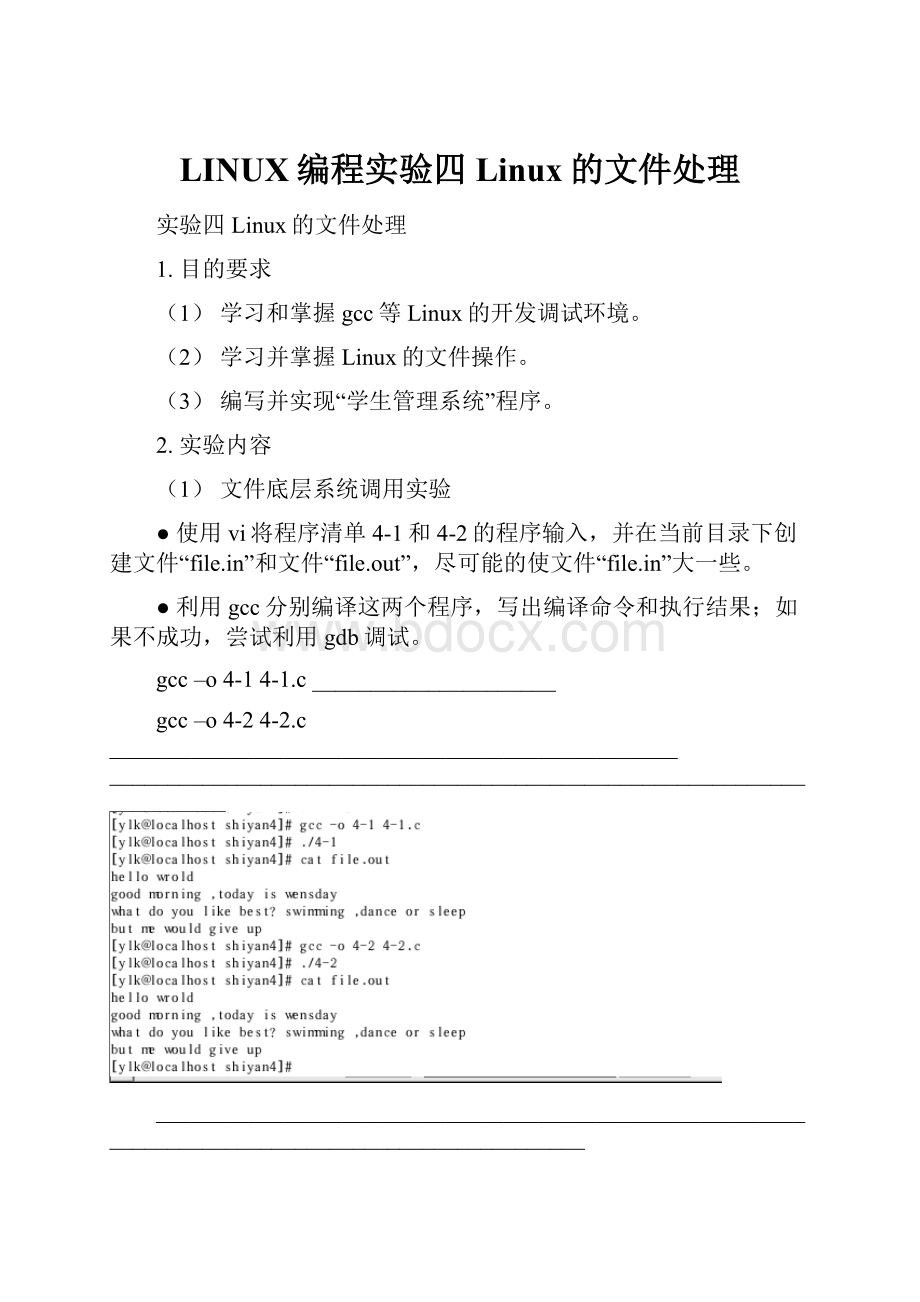LINUX编程实验四 Linux的文件处理.docx
《LINUX编程实验四 Linux的文件处理.docx》由会员分享,可在线阅读,更多相关《LINUX编程实验四 Linux的文件处理.docx(16页珍藏版)》请在冰豆网上搜索。

LINUX编程实验四Linux的文件处理
实验四Linux的文件处理
1.目的要求
(1)学习和掌握gcc等Linux的开发调试环境。
(2)学习并掌握Linux的文件操作。
(3)编写并实现“学生管理系统”程序。
2.实验内容
(1)文件底层系统调用实验
●使用vi将程序清单4-1和4-2的程序输入,并在当前目录下创建文件“file.in”和文件“file.out”,尽可能的使文件“file.in”大一些。
●利用gcc分别编译这两个程序,写出编译命令和执行结果;如果不成功,尝试利用gdb调试。
gcc–o4-14-1.c_____________________
gcc–o4-24-2.c_______________________________________________________________________________________________________________________
_________________________________________________________________________________________________
●仔细观察这两个程序,比较标准C的文件操作和Linux的系统调用open、read、write等的使用区别。
C文件系统调用fopen和fclose,fputc和fgetc进行对文件的读写,只需要指定文件名和读写方式,系统调用open,read,write等对文件进行读写,创建文件时要指定读写的权限,打开文件时,为了实现没有文件时创建文件,要加上特别的参数。
_________________________________________________________________________________________________________________________________________________________________________________________________________________________________________
●按照说明重新修改程序4-2,并使用time命令察看程序执行的时间效率上有何区别。
___每次只读写一个字符时用时多,因为每次都要启动磁盘,而利用数组的程序用时少,每次读写多个字符,启动磁盘的次数减少,所以用时少。
___________________________________________________________________________________________________________________________________________________________
●输入、编译并运行程序4-3和4-4,写出执行结果,并比较他们fseek和lseek在使用方法上的异同。
_
fseek使用的是FILE的指针,lseek使用的是文件描述符。
_____________________________________________________________________________________________________________________________________________
(2)目录信息的单层浏览
●使用vi将程序清单4-5和4-6程序输入。
●利用gcc分别编译这两个程序,写出编译命令和执行结果;如果不成功,尝试利用gdb调试。
_gcc–o4-54-5.c
gcc–o4-64-6.c
___________________________________________________________
____________________________________________________________________________________________
●仔细观察这两个程序,比较它们的区别。
(3)目录信息的完整浏览
●使用vi将程序清单4-7和4-8程序输入。
●利用gcc分别编译这两个程序,写出编译命令和执行结果;如果不成功,尝试利用gdb调试。
__gcc–o4-74-7.c
__gcc–o4-84-8.c
___________________________________________________________
____________________________
●仔细阅读、比较这两个程序,并写出目录浏览的算法描述。
_4-7程序不能传递参数,只能在程序内确定要浏览的目录路径,
4-8程序可以加参数_,如果没有参数,就默认为当前路径。
___________________________________________________________________4-7程序:
程序中提供浏览目录路径,调用opendir打开目录,然后进入,读取目录中文件,判断类型,如果是普通文件就输出文件名,如果是目录,就进入目录,循环调用函数,浏览文件
4-8程序:
运行程序时可以提供参数,然后浏览参数目录中的文件,如果没有提供就把当前目录当作参数,打开目录,进入目录,然后读取每项,判断文件类型,如果是目录,就循环调用浏览函数,如果是普通文件,就直接输出信息。
_________________________________________________________________________________________
(4)mmap、msync和munmap的使用
●使用vi将程序清单4-9程序输入。
●利用gcc编译程序,写出编译命令和执行结果;如果不成功,尝试利用gdb调试。
__gcc–o4-94-9.c
_
___________________________________________________________________________________________________________________________________________________________
●
仔细阅读程序,并画出程序流程图。
______________________________________________________________________________________________________________________________________________________________
(5)学习并分别使用标准C的文件操作函数和Linux的系统调用创建一个对学生基本信息进行操作(插入、修改和删除)的C程序,学生基本信息以结构体的形式存储在文件stu.info中。
structstu_info的定义如下:
structstu_info{
charstu_num[12];
charname[10];
shortintsex;/*0为女生,1为男生*/
charmobile_phone[12];
};
3.主要仪器设备及软件
(1)硬件:
计算机、网络
(2)软件:
VMWareworkstation、RedHat9.0
4.附录:
程序清单
(1)程序清单4-1
#include
#include
intmain(void)
{
charc;
FILE*in,*out;
if((in=fopen("file.in","r"))==NULL)
{
perror("fileopenerror!
");
exit(0);
}
out=fopen("file.out","w");
while((c=fgetc(in))!
=EOF)
fputc(c,out);
fclose(in);
fclose(out);
}
(2)程序清单4-2
#include
#include
#include
intmain()
{
//charblock[1024];
charc;
intin,out;
intnread;
in=open("file.in",O_RDONLY);
out=open("file.out",O_WRONLY|O_CREAT,S_IRUSR|S_IWUSR);
//将注释打开,并将两条语句的后一句注释掉,重新编译执行。
//while((nread=read(in,block,sizeof(block)))>0)
while((nread=read(in,&c,sizeof(c)))>0)
//write(out,block,nread);
write(out,&c,nread);
close(in);
close(out);
}
(3)程序清单4-3
#include
#include
#include
#include
#include
charbuf1[]="abcdefghij";
charbuf2[]="ABCDEFGHIJ";
voiderr_exit(char*err_s)
{
perror(err_s);
exit
(1);
}
intmain(void)
{
FILE*fp;
if((fp=fopen("hole.file","w"))==NULL)
err_exit("fileopenfail!
");
if(fwrite(buf1,sizeof(buf1),1,fp)!
=1)
err_exit("filewritebuf1error!
");
if(fseek(fp,40,SEEK_SET)==-1)
err_exit("fseekerror!
");
if(fwrite(buf2,strlen(buf2),1,fp)!
=1)
err_exit("filewritebuf2error!
");
fclose(fp);
}
(4)程序清单4-4
#include
#include
#include
#include
#include
charbuf1[]="abcdefghij";
charbuf2[]="ABCDEFGHIJ";
voiderr_exit(char*err_s)
{
perror(err_s);
exit
(1);
}
intmain(void)
{
intfd;
if((fd=open("hole.file",O_WRONLY|O_CREAT/*|O_APPEND,0644*/))==-1)
err_exit("fileopenfail!
");
if(write(fd,buf1,10)!
=10)
err_exit("filewritebuf1error!
");
if(lseek(fd,40,SEEK_SET)==-1)
err_exit("lseekerror!
");
if(write(fd,buf2,10)!
=10)
err_exit("filewritebuf2error!
");
}
(5)程序清单4-5
#include
#include
#include
intmain()
{
DIR*pDir=opendir(“MyDirectory”);
structdirent*pDirent;
structstatvStat;
if(pDir==NULL)
{
printf(“Can’topenthedirectory\”MyDirectory\”);
return1;
}
while((pDirent=readdir(pDir))!
=NULL)
{
lstat(pDirent->d_name,&vStat);
if(S_ISDIR(vStat.st_mode))
printf(“Directory:
%s\n”,pDirent->d_name);
else
printf(“File:
%s\n”,pDirent->d_name);
}
closedir(pDir);
return0;
}
(6)程序清单4-6
#include
#include
#include
intprintDir(char*path)
{
DIR*pDir=opendir(path);
structdirent*pDirent;
structstatvStat;
if(pDir==NULL)
{
printf(“Can’topenthedirectory:
%s”,path);
return-1;
}
while((pDirent=readdir(pDir))!
=NULL)
{
lstat(pDirent->d_name,&vStat);
if(S_ISDIR(vStat.st_mode))
printf(“Directory:
%s\n”,pDirent->d_name);
else
printf(“File:
%s\n”,pDirent->d_name);
}
closedir(pDir);
return0;
}
intmain()
{
char*dirPath;
printf(“pleaseinputbrowsedir’spath:
”);
scanf(“%s”,dirPath);
if(printDir(dirPath)==0)
return0;
else
return-1;
}
(7)程序清单4-7
/*Westartwiththeappropriateheadersandthenafunction,printdir,
whichprintsoutthecurrentdirectory.
Itwillrecurseforsubdirectories,usingthedepthparameterisusedforindentation.*/
#include
#include
#include
#include
#include
voidprintdir(char*dir,intdepth)
{
DIR*dp;
structdirent*entry;
structstatstatbuf;
if((dp=opendir(dir))==NULL){
fprintf(stderr,"cannotopendirectory:
%s\n",dir);
return;
}
chdir(dir);
while((entry=readdir(dp))!
=NULL){
lstat(entry->d_name,&statbuf);
if(S_ISDIR(statbuf.st_mode)){
/*Foundadirectory,butignore.and..*/
if(strcmp(".",entry->d_name)==0||
strcmp("..",entry->d_name)==0)
continue;
printf("%*s%s/\n",depth,"",entry->d_name);
/*Recurseatanewindentlevel*/
printdir(entry->d_name,depth+4);
}
elseprintf("%*s%s\n",depth,"",entry->d_name);
}
chdir("..");
closedir(dp);
}
/*Nowwemoveontothemainfunction.*/
intmain()
{
printf("Directoryscanof/home:
\n");
printdir("/home",0);
printf("done.\n");
exit(0);
}
(8)程序清单4-8
/*Westartwiththeappropriateheadersandthenafunction,printdir,
whichprintsoutthecurrentdirectory.
Itwillrecurseforsubdirectories,usingthedepthparameterisusedforindentation.*/
#include
#include
#include
#include
#include
voidprintdir(char*dir,intdepth)
{
DIR*dp;
structdirent*entry;
structstatstatbuf;
if((dp=opendir(dir))==NULL){
fprintf(stderr,"cannotopendirectory:
%s\n",dir);
return;
}
chdir(dir);
while((entry=readdir(dp))!
=NULL){
lstat(entry->d_name,&statbuf);
if(S_ISDIR(statbuf.st_mode)){
/*Foundadirectory,butignore.and..*/
if(strcmp(".",entry->d_name)==0||
strcmp("..",entry->d_name)==0)
continue;
printf("%*s%s/\n",depth,"",entry->d_name);
/*Recurseatanewindentlevel*/
printdir(entry->d_name,depth+4);
}
elseprintf("%*s%s\n",depth,"",entry->d_name);
}
chdir("..");
closedir(dp);
}
/*Nowwemoveontothemainfunction.*/
intmain(intargc,char*argv[])
{
char*topdir,pwd[2]=".";
if(argc!
=2)
topdir=pwd;
else
topdir=argv[1];
printf("Directoryscanof%s\n",topdir);
printdir(topdir,0);
printf("done.\n");
exit(0);
}
(9)程序清单4-9
/*WestartbydefiningaRECORDstructure
andthencreateNRECORDSversionseachrecordingtheirnumber.
Theseareappendedtothefilerecords.dat.*/
#include
#include
#include
#include
typedefstruct{
intinteger;
charstring[24];
}RECORD;
#defineNRECORDS(100)
intmain()
{
RECORDrecord,*mapped;
inti,f;
FILE*fp;
fp=fopen("records.dat","w+");
for(i=0;irecord.integer=i;
sprintf(record.string,"RECORD-%d",i);
fwrite(&record,sizeof(record),1,fp);
}
fclose(fp);
/*Wenowchangetheintegervalueofrecord43to143
andwritethistothe43rdrecord'sstring.*/
fp=fopen("records.dat","r+");
fseek(fp,43*sizeof(record),SEEK_SET);
fread(&record,sizeof(record),1,fp);
record.integer=143;
sprintf(record.string,"RECORD-%d",record.integer);
fseek(fp,43*sizeof(record),SEEK_SET);
fwrite(&record,sizeof(record),1,fp);
fclose(fp);
/*Wenowmaptherecordsintomemory
andaccessthe43rdrecordinordertochangetheintegerto243
(andupdatetherecordstring),againusingmemorymapping.*/
f=open("records.dat",O_RDWR);
mapped=